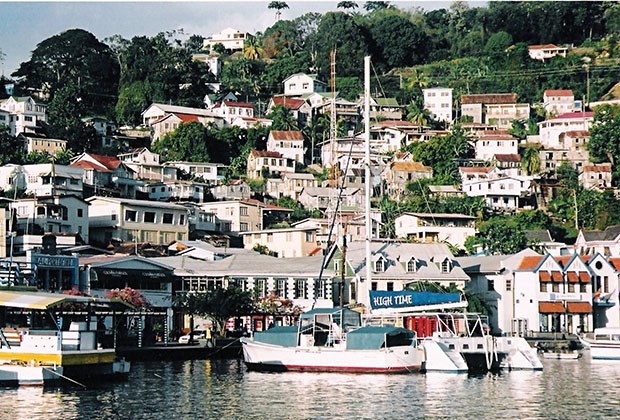His pearly white smile contrasts with his ebony-rich skin. He saunters barefoot, showing no urgency about getting anywhere (or at any time), and the slogan on his T-shirt depicts him to a tee. Although the catchphrase, "There's a little Carib in all of us," is advertising the island's local beer, by the end of our Grenada visit, it signifies a much deeper meaning.
Grenada is one of the three Windward Islands located in the Eastern Caribbean, and at only 440 square kilometres (133 square miles), is one of the smallest independent nations in the Western Hemisphere.
Lush rainforests drape the volcanic core of this tropical oasis and skinny roads weave over its terrain. During this week of island touring we jostle over crater-sized potholes and swerve around brown-eyed cows and tethered goats that languidly graze along the roadside.
Jerry-built stilted homes cling to one another and teeter like tipsy sailors. Their occupants lounge about on sun-baked verandahs, just waiting for people and time to pass.
"There's no rush, Mon," our driver says, with a toothy grin. "It's always island time on Grenada."
While cruising the verdant landscape, fragrant spice plants and tropical blossoms border our path. Towering mahogany and giant gommiers hug up to fruit trees that bear mangoes, nutmeg, sea grapes and breadfruit. Prickly pineapples cavort with 16 breeds of bananas, stands of bamboo shoot above broadleafed callaloos and clumps of coconuts are shaded by billowy palms.
It comes as no surprise this Caribbean dreamscape has been dubbed the Isle of Spice, and we discover that it's second to Indonesia for the global export of nutmeg. History unites with the bountiful harvest at
Dougaldston Spice Boucan where we get a glimpse of the traditional preparation of cocoa.
After fermenting for six days in a sweat house, the beans are splayed on sunbaked trays and, with the help of shuffling feet, are rotated every hour until they are dried to perfection.
"The process may seem primitive," our guide explains as we witness a young Grenadian woman go to work, "but it's been done this way for centuries and it still works today."
After the shells are peeled, the cocoa is molded into balls and when mixed with boiling water and sugar, they transform into a yummy hot drink.
Others may prefer to spike the concoction with a shot of over-proof rum which, on Grenada, is never too far away. As well as a number of modern-day processing plants, we check out the River Antoine Rum Distillery where they've been brewing the conventional way since 1785. A massive water-wheel
powers the mill that crushes sugar cane and extracts the precious juice. It's then channeled through to the boiling house, to the distillery and bottled at a potent 75 per cent proof.
Although it's difficult to imagine any strife in this peace-loving nation, it was not always a pretty picture.
Like most West Indian islands, there had been an ongoing battle between the native Arawaks and Caribs, then by Caribs and French, and finally in 1795 by French and British.
Nearly two centuries later, upheaval fell on Grenada's shores, once again, when the U.S.
troops invaded in 1983 to successfully overthrow a Marxist government. Today, Grenada is an independent democratic nation, a member of the British Commonwealth and is as peaceful as it is picturesque.
Travel Writers' Tales is an independent travel article syndicate.



